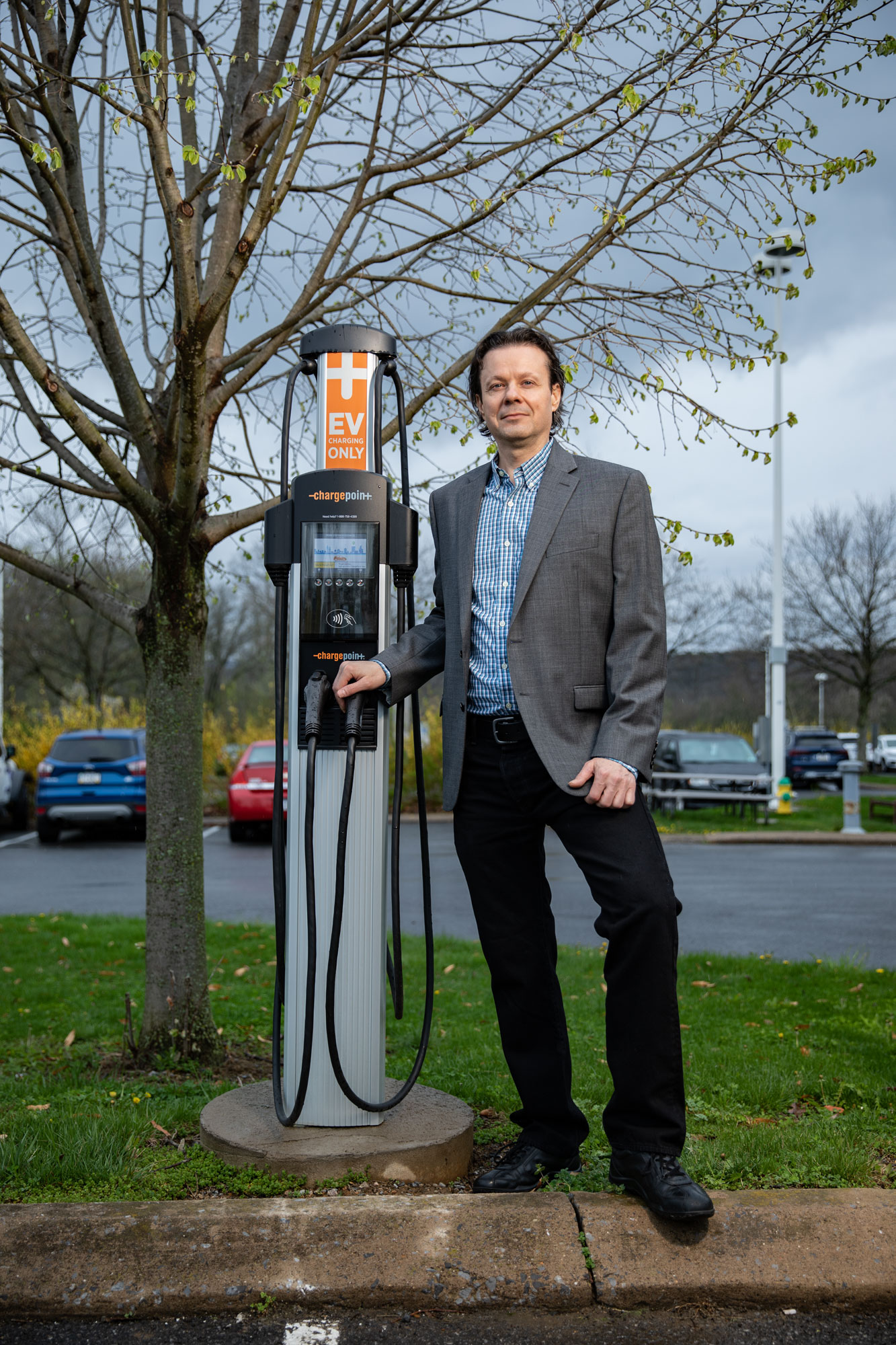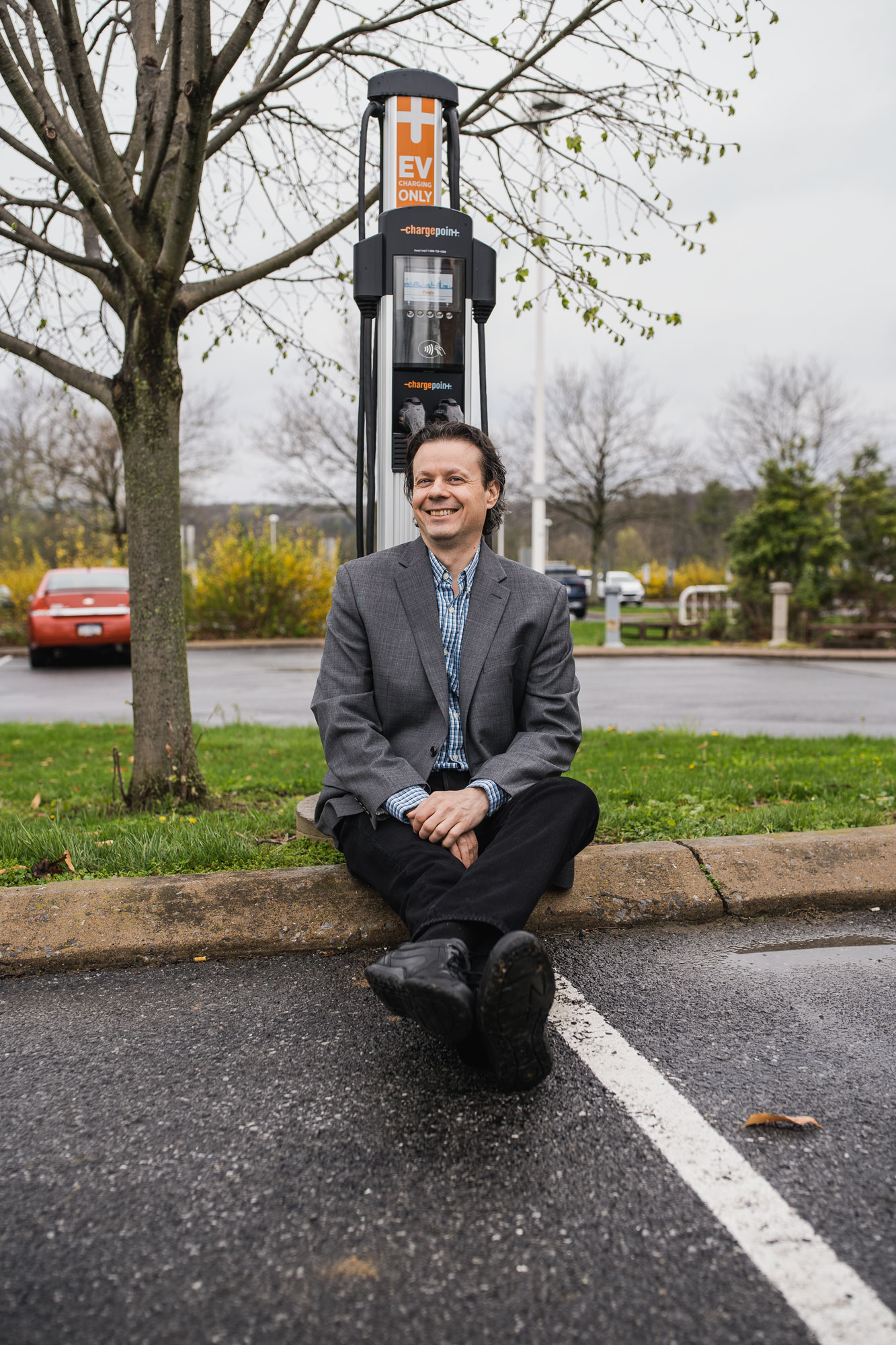Study finds that programs targeting electric vehicle buyers could accelerate U.S. vehicle fleet electrification, helping to meet climate goals.

A study co-authored by Sergey Naumov finds that “cash for clunkers” programs could accelerate vehicle electrification in the U.S., making charging stations like this more common.
A new research study examines the impacts of different Cash for Clunkers (C4C) program designs, using a model incorporating consumer automobile purchasing behavior, the light-duty vehicle fleet (cars, SUVs, pickup trucks) and vehicle turnover, and United States electric vehicle market development.
The study, co-authored by Sergey Naumov, assistant professor of supply chain management at the Penn State Smeal College of Business, finds that implementing a C4C program in which people buying electric vehicles (EVs) could retire their gasoline-powered vehicles for a cash incentive rather than trading them in could accelerate U.S. vehicle electrification and reduce greenhouse gas (GHG) emissions at a reasonable cost.
“Transportation generates about a third of all the GHG gas emissions in the U.S., and almost 60% of those are from more than a quarter of a billion gasoline-powered cars, SUVs, and pickup trucks,” Naumov says.
Most efforts by policymakers and automakers have so far focused on increasing the share of EVs in new vehicle sales. However, the impacts of policies designed to accelerate EV adoption are inherently constrained by the slow turnover of the vehicle fleet. Research shows the average light-duty vehicle (LDV) in the United States has a useful life of about 17 years, and many remain in use for 30 years or more (especially more-polluting light trucks). Even with EV sales on the rise, the study shows that it will take decades for the existing U.S. fleet to electrify, absent additional policies. Even if EV market share in new sales became 100% today and stayed there, it would take about 20 years to reach 90% EV share in the installed base.
“In the meantime, hundreds of millions of fossil-fuel-powered vehicles will remain in use, polluting our communities, emitting greenhouse gases and worsening climate change,” Naumov says. “Promoting the purchase of new EVs is not going to be enough to meet 2050 U.S. climate goals. We must accelerate the retirement of existing fossil-fuel-powered vehicles and replace them with new electric vehicles to achieve greater emissions reduction at reasonable cost.”
The study examined the impacts of different ways to design a C4C program using a model of consumer behavior, LDV fleet turnover, and EV market development in the U.S. The authors simulated fleet evolution and emissions through 2050 for a scenario without C4C and compared it to policies with different C4C incentive levels up to $12,000 per eligible vehicle, about the same as the incentives for EV purchases proposed by the Biden Administration.
The authors also considered whether C4C should apply only to those buying a new EV or also include those buying a new, highly efficient gas-powered vehicle. As expected, broader eligibility leads more people to opt for C4C. But focusing a C4C program solely on people buying new EVs led to larger and more cost-effective emissions reductions.
Why? The researchers attribute the larger emissions drop of the EV policy to two factors. First, electric vehicle emissions are lower than emissions from fossil-fuel powered vehicles even if they are very efficient. Second, and more importantly, the more EVs are purchased, the faster the EV market grows, driving EV costs down. Lowering costs leads to increasing make and model variety, promoting charging infrastructure deployment, and boosting consumer familiarity with and willingness to buy EVs, all further boosting sales.
“While main benefits of the C4C policy designed to incentivize EVs come from bootstrapping the EV market formation, it doesn’t mean that any policy that promotes sales of EVs would have similar environmental benefits,” Naumov says. “When existing tax credits or incentives boost EV sales, traded-in gasoline vehicles are not discarded, they enter the used-vehicles market and, after being resold, keep driving and polluting the environment for many years. C4C policy discards retired vehicles, creating a greener vehicle fleet overall.”
The researchers went on to analyze how complementary policies such as pricing carbon pollution and speeding decarbonization of the electric grid might further enhance the benefits of C4C.
“Promoting the purpose of new EVs is not going to be enough to meet 2050 U.S. climate goals.”
A price on carbon pollution and policies such as the proposed Clean Electricity Performance Program enhance the emissions reductions from C4C more than the sum of their individual parts could, and the revenue generated by the carbon price could offset program costs or be rebated to the public.
Even if C4C policies are cost effective, the distributional and equity impacts of these policies must be considered. C4C programs will primarily benefit more affluent individuals who buy the majority of new cars, while low-income individuals tend to purchase used vehicles or forgo car ownership altogether, instead relying on public transportation. However, by accelerating fleet turnover, C4C policies speed reductions in harmful tailpipe emissions. The adverse health impacts of these emissions are disproportionately borne by the poor and especially by people of color. Reductions in fossil fuel use induced by C4C help these groups by reducing morbidity, mortality, days of lost income, and health care costs, among other co-benefits.

The authors also considered impacts on automobile manufacturing and supply chain. C4C policy induces a permanent increase in cumulative auto production, stimulating manufacturing and service jobs, but creates transient challenges with implications for production and capacity planning.
“The introduction of the C4C policy immediately increases new vehicle sales, potentially stressing manufacturing capacity and creating supply chain bottlenecks (especially for EV-specific battery and electric motor components), but sales temporarily drop when C4C ends, requiring the production to fall for some period,” Naumov explained. “Gradual phase-in and out of C4C policy could mitigate supply chain shocks, but adequate coordination among government, auto industry, and suppliers is essential.”
Naumov, John Sterman, Jay W. Forrester Professor of Management at the MIT Sloan School of Management, and David R. Keith, assistant professor of system dynamics at the MIT Sloan School of Management, are co-authors of “Accelerating Vehicle Fleet Turnover to Achieve Sustainable Mobility Goals,” which was published in The Journal of Operations Management.




